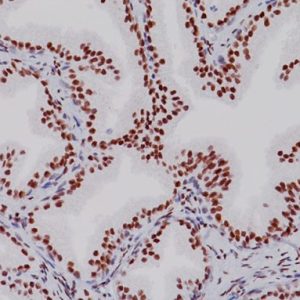Description
E-Cadherin is a transmembrane glycoprotein that plays a key role in cellcell adhesion in epithelial tissues (1-2). The adherens junction between epithelial cells is comprised of extracellular domains of E-Cadherin from adjacent cells, which interact through a molecular zipper motif. In normal tissues, immunostaining of E-Cadherin is localized to the membrane of epithelial cells, consistent with its role in cell adhesion. Immunohistochemical studies have shown E-Cadherin to be expressed in breast ductal carcinoma with loss of expression in lobular carcinoma (1-2). As a result, mouse monoclonal anti-E-Cadherin [HECD-1 has been used by pathologists to differentiate between ductal and lobular carcinomas of the breast, with currently published sensitivity and specificity of approximately 90% (3). Rabbit monoclonal E-Cadherin antibody may combine the best properties of both monoclonal antibodies and rabbit antisera.
SPECIFICATIONS
Specifications
| INTENDED USE | IVD |
|---|---|
| FORMAT | Concentrate, Predilute |
| VOLUME | 0.1 ml, 0.5 ml, 6.0 ml |
| SPECIES REACTIVITY | Human; others not tested |
| SOURCE | Rabbit Monoclonal |
| CLONE | CDH1/2208R |
| ISOTYPE | IgG |
| ANTIGEN | Recombinant full-length human E-Cadherin protein |
| POSITIVE CONTROL | Normal breast or breast ductal cell carcinoma |
DATASHEETS & SDS
REFERENCES
1. de Deus Moura R, et al. Immunohistochemistry applied to the differential diagnosis between ductal and lobular carcinoma of the breast. Appl Immuohistochem Mol Morphol. 2013 Jan;21(1):1-12.
2. Dabbs DJ, Bhargava R, Chivukula M. Lobular versus ductal breast neoplasms: the diagnostic utility of p120 catenin. Am J Surg Path. 2007 Mar;31(3):427-37.
3. Moriya T, et al. The role of immunohistochemistry in the differential diagnosis of breast lesions. Pathology. 2009 Jan;41(1):68-76.
4. Center for Disease Control Manual. Guide: Safety Management, NO. CDC-22, Atlanta, GA. April 30, 1976 “Decontamination of Laboratory Sink Drains to Remove Azide Salts.”
5. Clinical and Laboratory Standards Institute (CLSI). Protection of Laboratory Workers from Occupationally Acquired Infections; Approved Guideline-Fourth Edition CLSI document M29-A4 Wayne, PA 2014.







Reviews
There are no reviews yet.